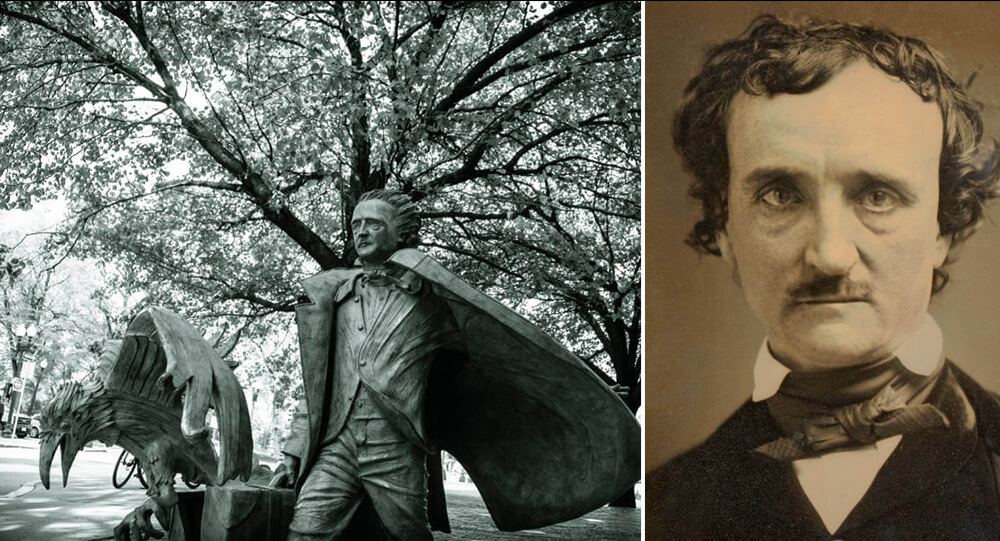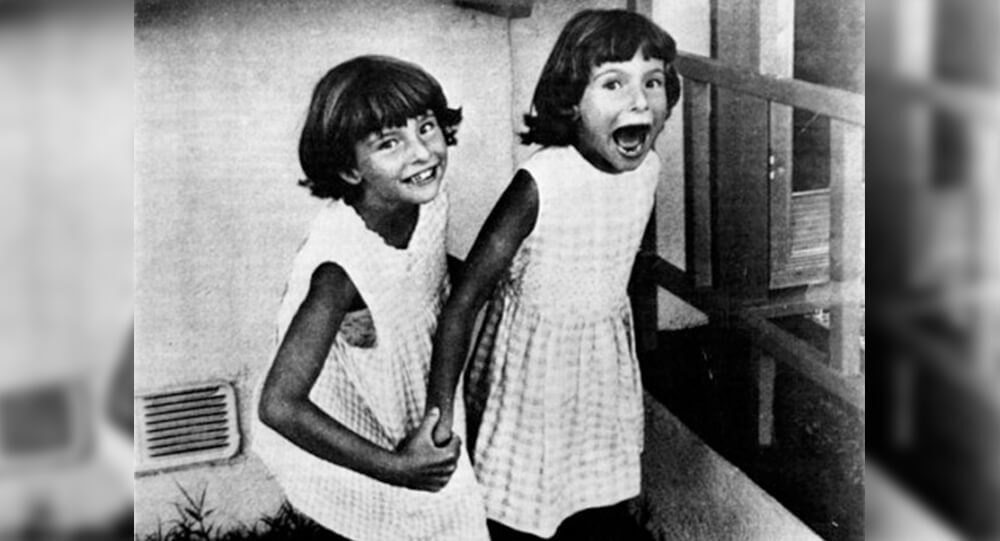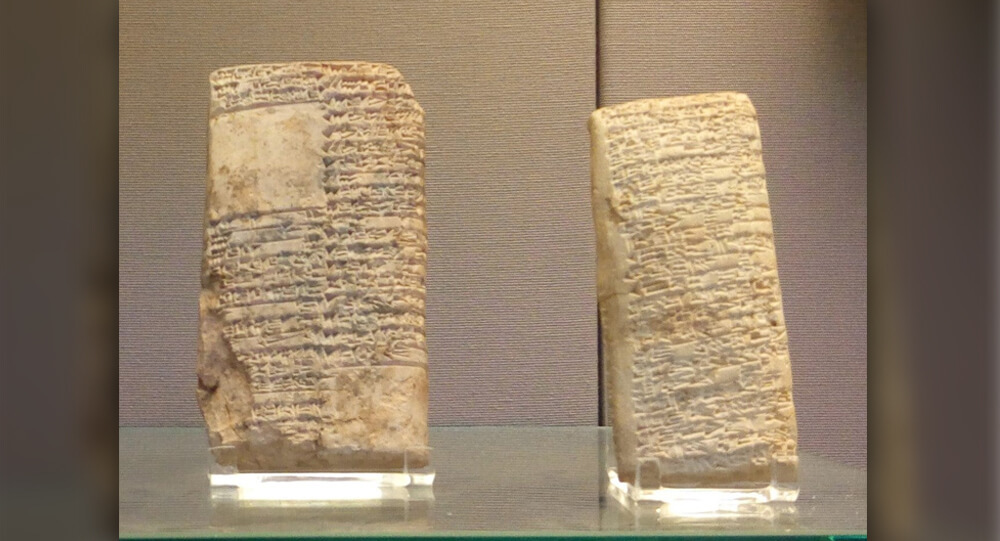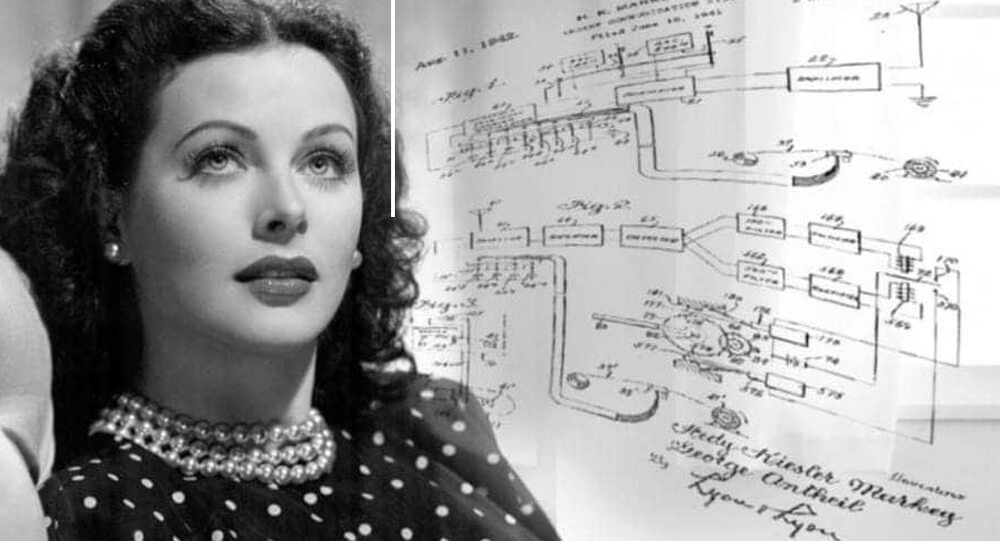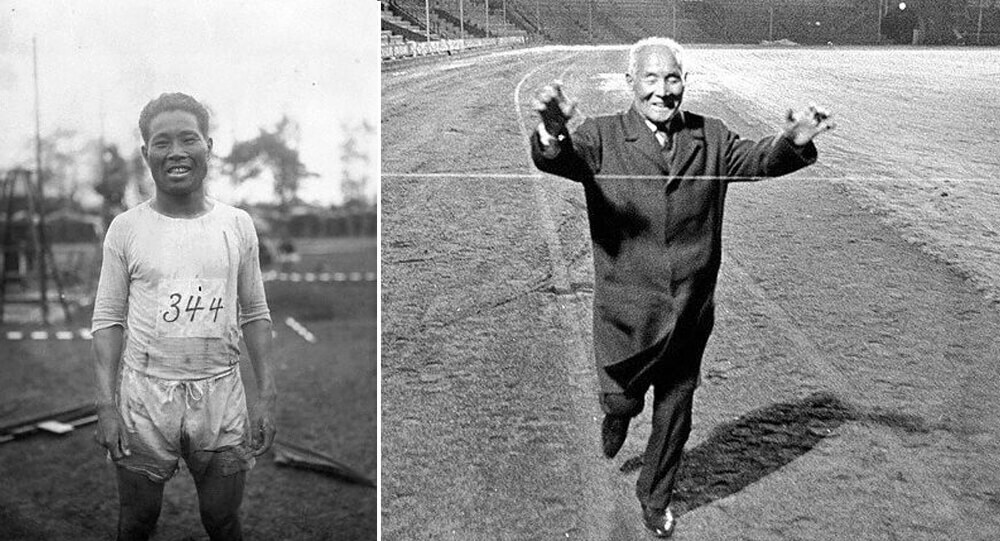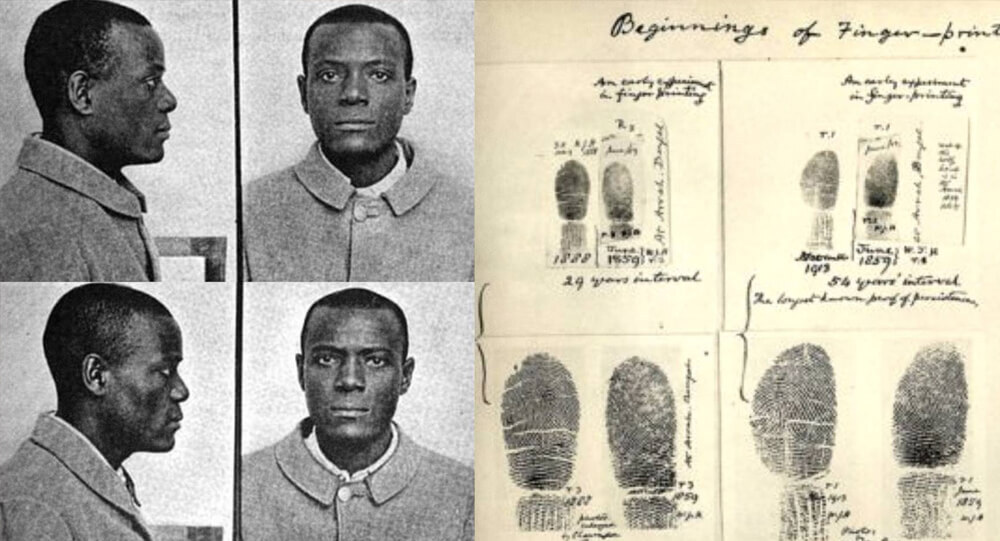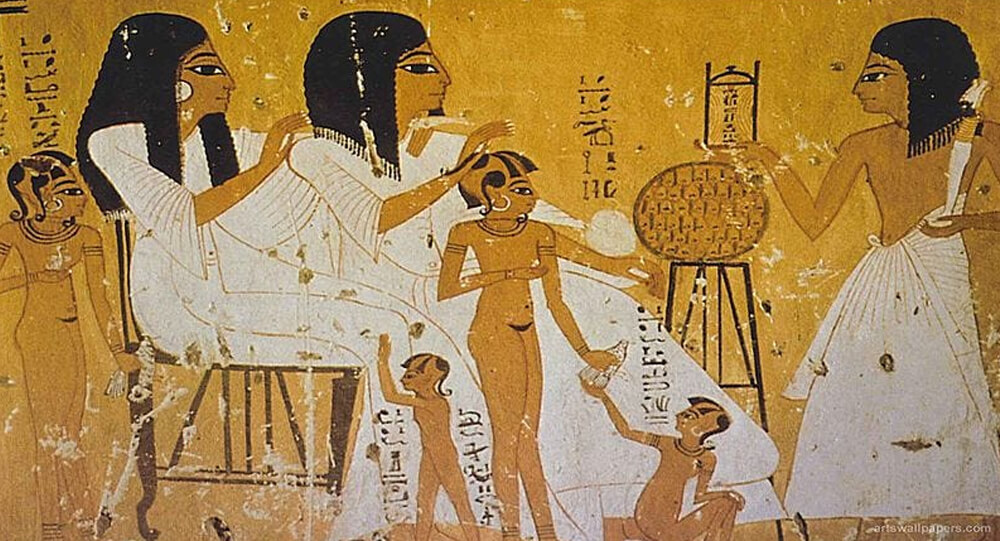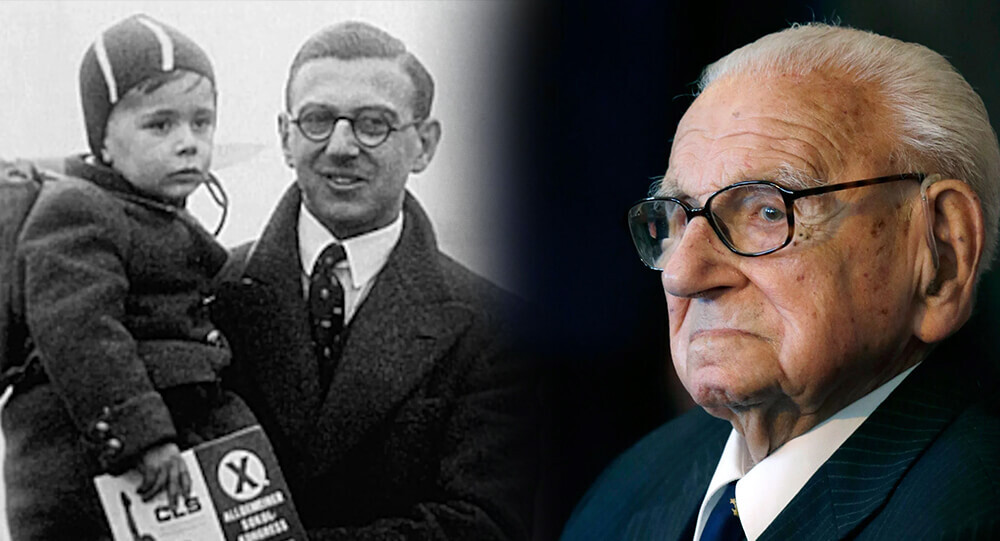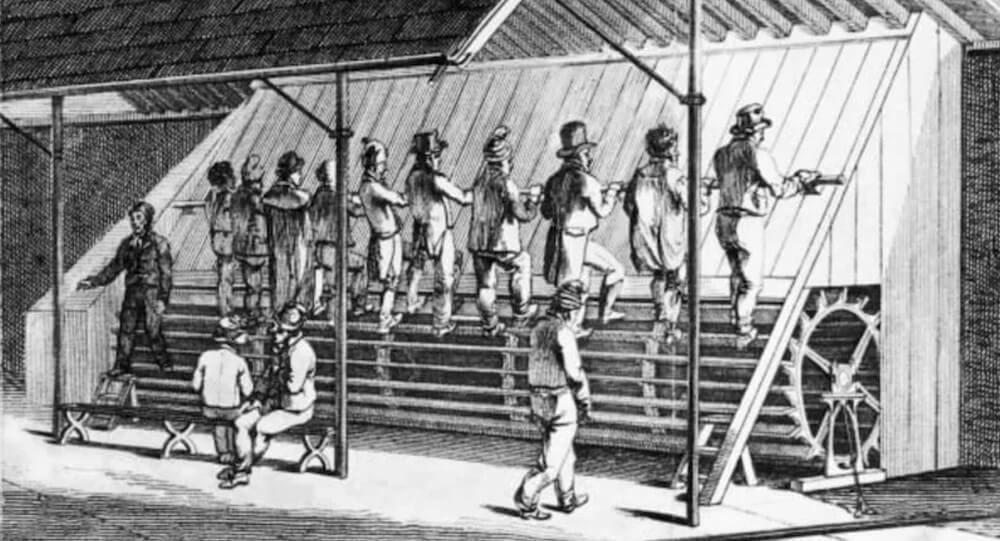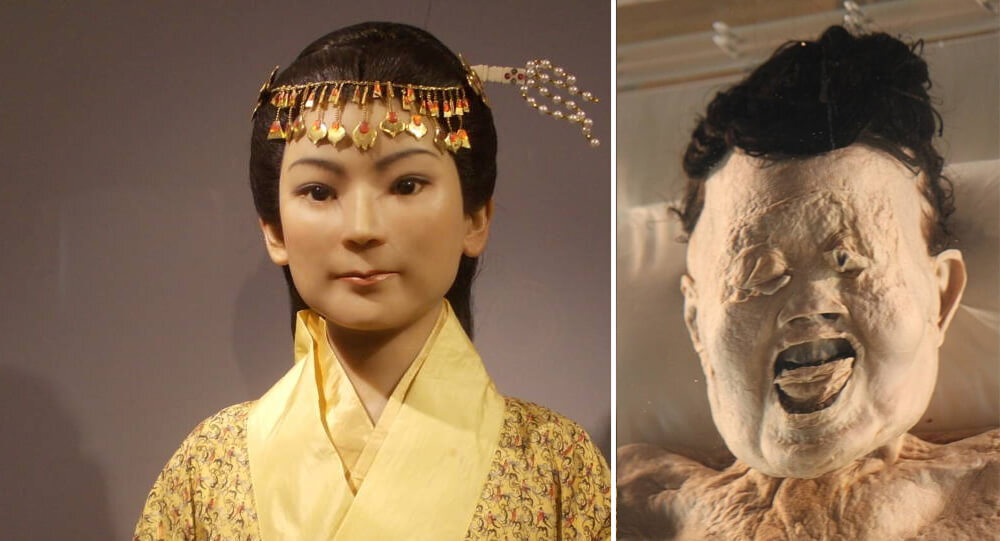
Xin Zhui, also known as Lady Dai, is a mummified woman from China’s Han dynasty (206 BC-220 AD) who is still soft to the touch, has natural hair, and has ligaments that still bend, much like a living person. She is more than 2,000 years old. She is regarded as the most expertly preserved human mummy in recorded history. This is her incredible tale.
The Shocking Discovery Of Xin Zhui, The “Lady Dai” Mummy
When workers were excavating close to an air raid shelter outside of Changsha in 1971, they almost literally stumbled upon Xin Zhui’s enormous tomb. More than 1,000 priceless artifacts, including make-up, toiletries, hundreds of pieces of lacquerware, and 162 carved wooden figures that represented her staff of servants, were kept in her funnel-shaped crypt. Even a meal was prepared for Xin Zhui to eat in the afterlife.
While the intricate structure was impressive and had remained intact for almost two thousand years, what really astounded researchers was Xin Zhui’s physical state.
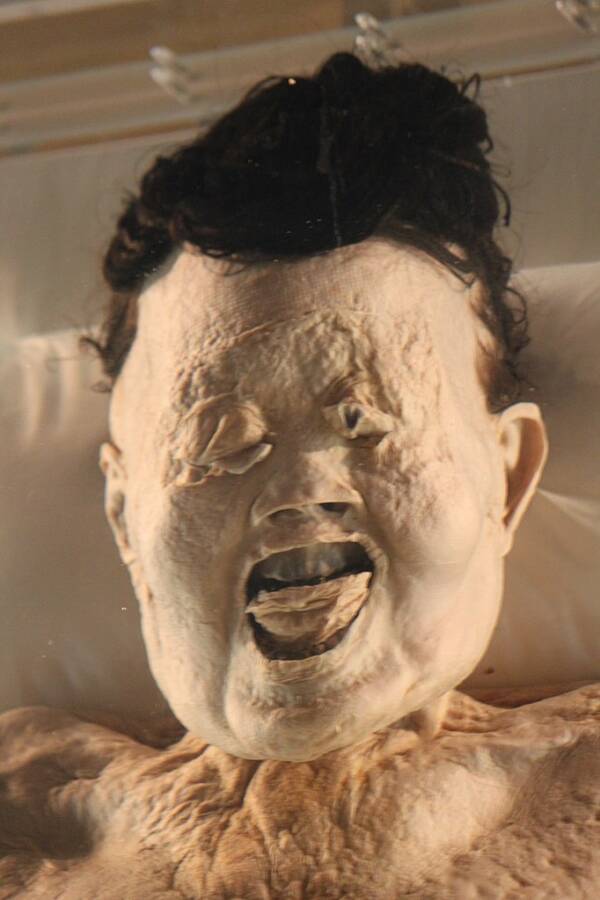
When she was discovered, it was discovered that she had retained the skin of a living person, which was still supple and elastic to the touch. Her original hair, including that on her head and inside of her nostrils, as well as her eyebrows and eyelashes, were discovered to be in tact.
Baffled Researchers Begin Studying The World’s Best-Preserved Mummy
She died in 163 BC, so scientists were able to perform an autopsy, during which they found that her 2,000-year-old body was in comparable condition to someone who had just passed away.
But as soon as the oxygen in the air touched Xin Zhui’s body, her preserved corpse was compromised, and she started to deteriorate. As a result, the pictures of Xin Zhui that we currently possess do not do its initial discovery justice.
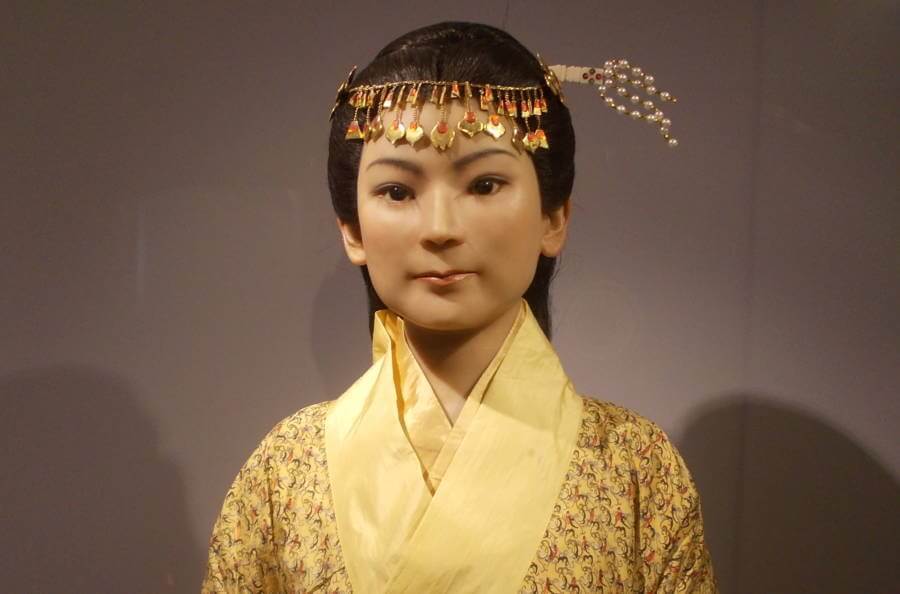
Researchers also discovered that she had all of her organs, and that type-A blood was still present in her veins. Her official cause of death—a heart attack—was revealed by the presence of clots in these veins.
Gallstones, high cholesterol, high blood pressure, and liver disease were among the additional illnesses that were discovered throughout Xin Zhui’s body.
Pathologists even discovered 138 undigested melon seeds in Lady Dai’s stomach and intestines while examining her. It was safe to assume that the melon was her final meal, consumed just before the heart attack that ultimately claimed her life, as such seeds typically take an hour to digest.
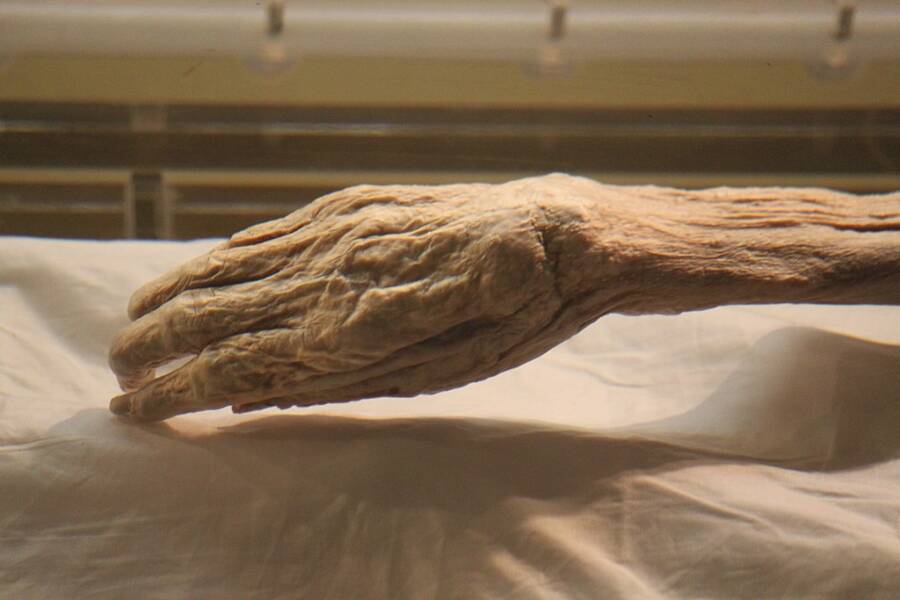
How Is Xin Zhui’s Lady Dai Mummy So Well-Preserved?
Researchers give credit to Lady Dai’s elaborate and airtight tomb. Xin Zhui was buried almost 40 feet underground, inside the smallest of four pine box coffins, each one set inside the other (imagine a Matryoshka set, where the dead body of an ancient Chinese mummy is revealed once you reach the smallest doll).
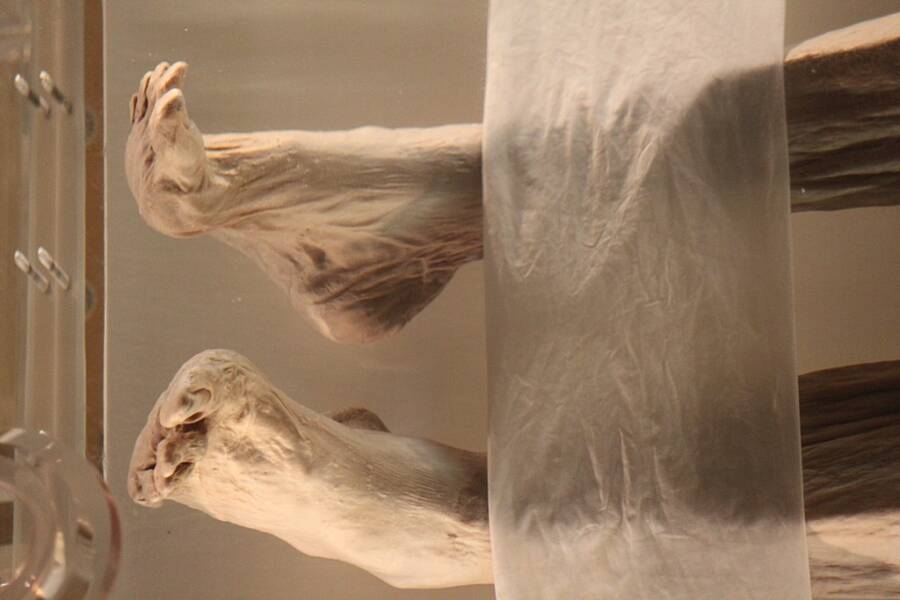
Her body was discovered in 21 gallons of a “unknown liquid” that was tested and found to be mildly acidic and contain traces of magnesium while being wrapped in twenty layers of silk fabric.
Her eternal chamber was sealed with clay and packed with moisture-absorbing charcoal to keep out oxygen and bacteria that cause decay. A thick layer of paste-like soil covered the floor. After that, three more feet of clay were used to seal the top, keeping water from entering the building.
The search for immortality
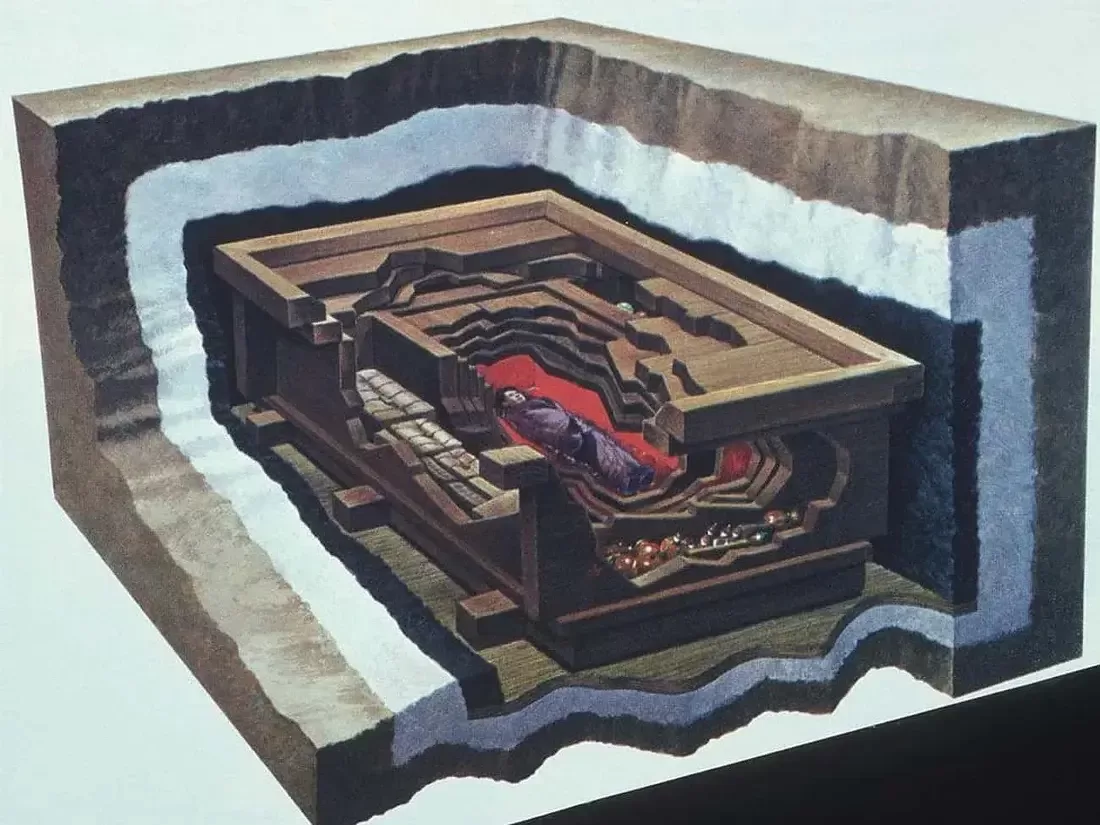
The ancient Chinese had a fascination with the afterlife.
It was crucial for them to keep the body as intact as possible in order to enter the underworld.
After she passed away, the body of Xin Zhui was cleaned with wine and flagrant water, both of which have antibacterial properties that prevent the body from decomposing.
Twenty layers of clothing were tightly layered around the body. The corpse was buried in an airtight casket. A second airtight coffin was then placed inside the coffin. There were four coffins surrounding one another.
The Xin Zhui’s coffins were the equivalent of a Russian nesting doll.
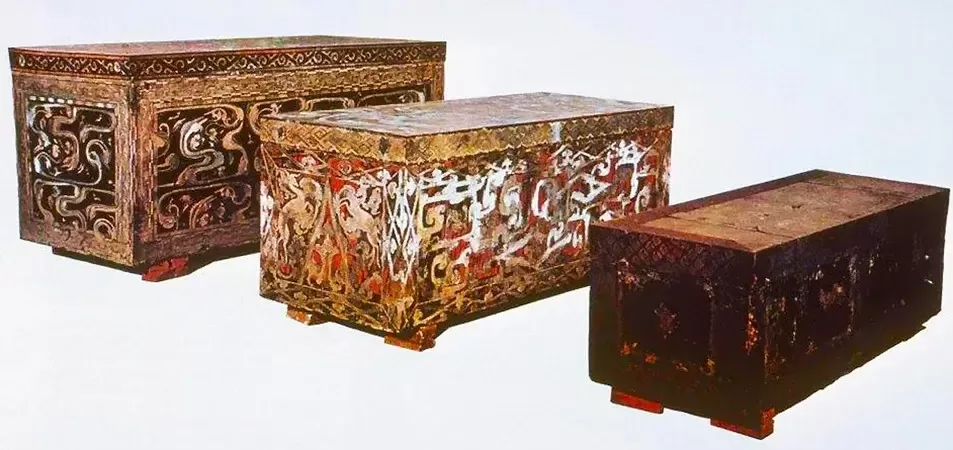
The coffin was buried 12 meters (40 feet) underground, in a place with a constant, cool temperature. A layer of white clay and charcoal that was 3 feet thick (1 meter) served as the coffin’s protective covering.
The body was discovered floating in an unidentified translucent liquid by the scientists when they opened the innermost coffin.
Scientists were unable to determine what kind of liquid it was; all they knew about it was that it was acidic. However, the scientists who touched the substance endured months of hand rashes.
Who Was Xin Zhui Before She Became The Mummy We Know Today?
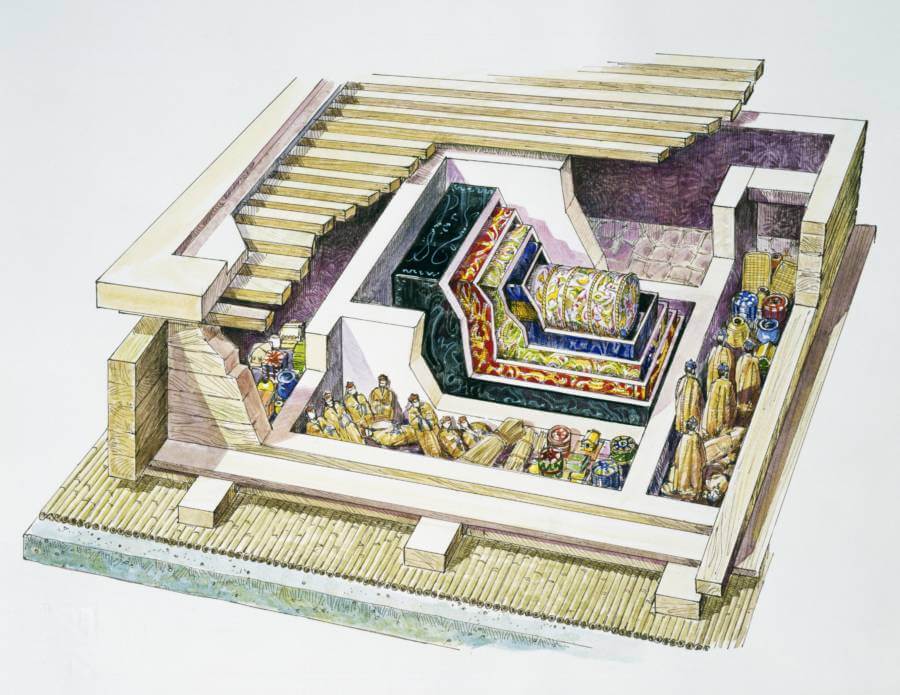
In contrast to her burial and death, we know relatively little about Xin Zhui’s life.
Li Cang (the Marquis of Dai), a prominent Han official, was married to Lady Dai, who passed away at the young age of 50 due to her penchant for excess. Her fatal cardiac arrest was thought to have been caused by a lifetime of obesity, a lack of exercise, and a lavish and too much diet.
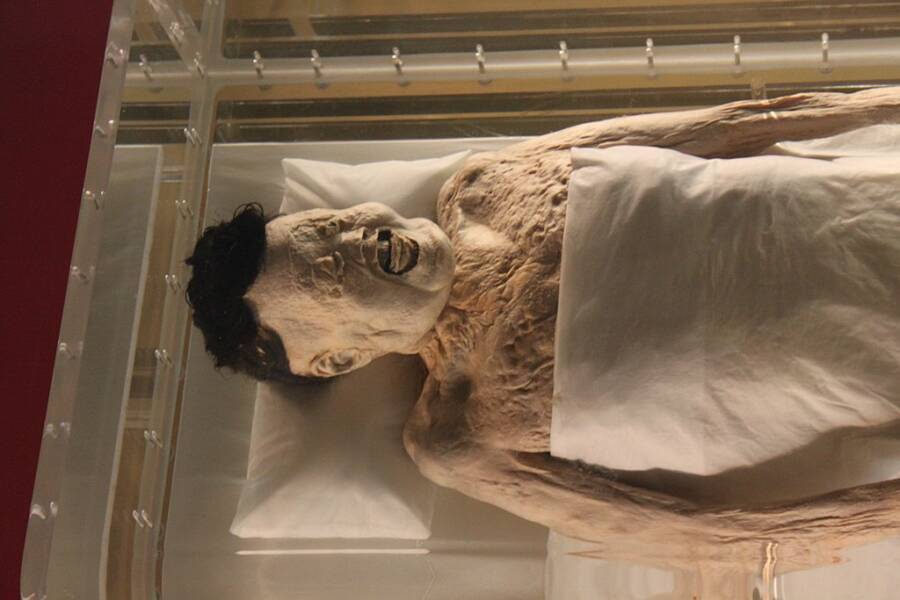
She may still have the best-preserved corpse in history, though. The primary subject of their research into corpse preservation is Xin Zhui, who is currently kept in the Hunan Provincial Museum.

The Forgotten Story of Semipalatinsk and the Soviet Nuclear Experiments
Between 1949 and 1989, the Semipalatinsk Test Site in Kazakhstan became the primary location for Soviet nuclear weapons tests, exposing millions of unsuspecting villagers to radioactive fallout. Known as the “Polygon of Suffering,” this remote desert witnessed 456 nuclear detonations that caused widespread health crises, birth defects, and generational genetic damage. This article narrates the chilling legacy of Semipalatinsk, unveiling the human cost of Cold War arms development and the ongoing struggle for healing and recognition in Kazakhstan.

Tunnels Dug by ancient giant sloths, A South American Megafauna
For years, scientists didn’t know what caused mysterious cave networks in South America. In 2010, they learned that the caves were actually tunnels dug by ancient giant sloths

Sylvan Goldman: The Visionary Who Revolutionized Shopping with the Cart
The inventor of shopping carts, Sylvan Goldman, had to hire several male and female models to push carts around in his store, demonstrate their utility, and explain their use to other customers, due to not catching on initially.

The Arabia Steamboat: Unearthing a 19th Century Time Capsule from the Missouri River
The Arabia was a steamboat that sank in the Missouri River in 1856. Over time, the river shifted 800 meters to the east, eventually turning the site of the sinking into a field. The steamboat remained under 45 feet of slit and topsoil until 1988, when it was excavated. The mud, as it turned out, was such a great preserver that most of the artifacts on board were found to be intact. They even found jars of preserved apples that were still edible!

Why the Brooklyn Bridge Was Once Crossed by 17 Camels and 21 Elephants
On May 30, 1883, a rumor that the Brooklyn Bridge was going to collapse caused a stampede, which killed at least at twleve people. To prove the bridge was safe, P.T. Barnum led a parade of 21 elephants over it.

Ancient Jericho: The First Walled City In History
The ancient city of Jericho is the world's oldest walled city, with evidence of stone fortifications dating back nearly 9000 years.

The unbroken seal on King Tutankhamun's tomb until 1922
The unbroken seal of Tutankhamun's tomb before it was opened in 1923, it was unbroken for over 3000 years.

George Dantzig solved two famous “unsolved” problems in statistics mistakenly as assignment
In 1939, George Dantzig arrived late to his statistics class. On the board were two famous “unsolved” problems in statistics written as an example by his professor. Dantzig mistook the examples for homework assignments. He solved the “unsolved” problems and submitted the homework to his professor a few days later. His solutions earned him a doctorate.

Inside The Mysterious Death Of The Famed Gothic Writer Edgar Allan Poe
Hours before his death Edgar Allen Poe was found on the streets of Baltimore. He was incoherent, wearing another man’s clothes, and unable to explain how he got there. The cause of his death is an unsolved mystery.

3 men lived on top of a billboard in tents for almost 9 months
From 1982-1983, three men in Allentown PA competed in a radio contest in which they lived on top of a billboard in tents. Whoever stayed up longest would win a house. Due to economic pressure from the recession, none of the contestants wanted to give up, so the contest lasted almost 9 months.

Thomas Baker's heroic act that earned him the "Medal of Honor" was 8 bullets until death
Thomas Baker instructed his team to leave him with a pistol and eight bullets propped up against a tree after he was injured. Later, American troops discovered the now-deceased Baker in the same location, lying next to eight dead Japanese soldiers and carrying an empty pistol.

Before Radar: How Giant Acoustic Mirrors Detected Enemy Aircraft in WWI and WWII
Long before radar revolutionized air defense, enormous acoustic mirrors and specialized sound locators stood as the first line of defense against enemy aircraft. Designed as giant “ears,” these structures amplified distant engine noises, allowing operators to detect incoming planes by sound alone. Dive into the intriguing world of these pioneering listening devices, their operation, limitations, and enduring legacy in military history.

Mother who spent entire life savings for daughter’s cancer treatment won the lottery
A mother won $2 million from a $10 scratch-off lottery ticket after she spent all of her entire life savings to pay her daughter’s cancer treatment. She bought the winning ticket after her daughter’s last cancer treatment.

The youngest person executed, George Stinney Jr was proven innocent
In 1944, George Stinney Jr. was 14 years old when he was executed in South Carolina. It took only ten minutes to convict him — and 70 years to exonerate him.

Poto And Cabengo: The Secret Language Of Twins
Poto and Cabengo, as the two girls called each other, communicated in their own language. The twins were ignored by their parents and secluded from the outside world because their father felt they were developmentally retarded, and their unique language evolved as a result of that neglect.

How European Rabbits Took over Australia
In 1859, wealthy settler Thomas Austin released 13 wild rabbits on his Australian estate. By 1920, their population grew to 10 billion.

Ea-Nasir: world's oldest written customer complaint
This clay tablet, written in cuneiform, is the oldest known written customer complaint about the delivery of poor quality copper ingots. Originally from ancient Babylon, the tablet dates back to 1750 BCE, and it was written by a customer named Nanni to a merchant named Ea-Nasir. It is currently housed in the British Museum.

Hedy Lamarr, A Hollywood actress who also a mathematician and inventor
Hollywood actress Hedy Lamarr was also a mathematician and the inventor of frequency hopping spread spectrum, a technology still used for bluetooth and wifi

Shizo Kanakuri’s 1912 Olympic Marathon Finished 54 Years
At the 1912 Olympics, a marathon runner quit and went home to Japan without telling officials and was considered a missing person in Sweden for 50 years. In 1966, he was invited to complete the marathon. His time: 54 years, 8 months, 6 days, 5 hours, 32 minutes, and 20.379 seconds.

Will & William Wests: The puzzling situation of two inmates who are identical but not related
These are the mugshots of Will West and William West, and they are not related. They were both sent to Leavenworth Prison at the same time, in 1903, and after some confusion, the staff understood they had two different prisoners with the nearly same name, who looked exactly alike. They are part of the reason fingerprints are now used as identification.

Ancient Egyptians Had Pregnancy Tests Over 3500 Years Ago
The ancient Egyptians used a pregnancy test that involved potentially pregnant women peeing on barley and wheat seeds. Plant growth indicated pregnancy: barley for a boy and wheat for a girl. Later tests revealed that pregnant women's urine causes plant growth 70% of the time, whereas non-pregnant women's urine does not.

Nicholas Winton ‘British Schindler’: Man who rescued 669 Czech children from Nazis
A man named Nicholas Winton saved 669 kids during WWII and lived almost all his life without letting people know.

15 interesting facts about Queen Elizabeth II
Queen Elizabeth II, who ruled Britain for 70 years, has away at the age of 96. She was the country's longest-reigning monarch. Here are some little-known facts about her.

History of Treadmill, punishment for prisoners
Treadmills were originally a punishment used to harness human power on a giant wheel used to grind grains, hence the name "treadmill." The History of Treadmill

During the 1996 Olympic bombing, Richard Jewell falsely accused of committing the crime after saving dozens of people
Richard Jewell, an American security guard, discovered a bomb during the 1996 Olympic Games in Atlanta and assisted in the evacuation, but was later wrongfully accused and faced public scrutiny. He was cleared, but it had a lasting impact on him until his death in 2007 at the age of 44.









